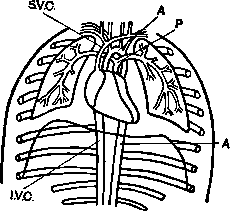Voice Training In Speech And Song - online tutorial
The Structure And Use Of The Vocal Organs, And The Means Of Securing Distinct Articulation.
| Share page | Visit Us On FB |
|
THE BREATHING APPARATUS. 21 |
||
|
six lower ribs, to the sternum, and to the spine, and of a membranous tendon- inside (Fig. 14).
When at rest the diaphragm is curved or arched upwards, forming a convex floor for the chest, on the centre of which is situated the heart, and on the outsides the lungs, it also forms a domed-shaped roof for the abdomen (Fig. 13). In the dome are placed the liver on the right and the stomach and spleen on the left. |
||
 |
||
|
|
||
|
Fig. 13.—Diagrammatic Sketch of the Diaphragm,
Forming an air-tight partition between the Chest and the Abdomen. The Chest contains the Heart and the Lungs. Into the Right Curve, which is the larger of the two curves of the Diaphragm, fits the Liver, and into the Left Curve the Stomach. Upon the tendon rests the Heart. P, the Pulmonary Artery, sending branches into each lung from the right side of the heart; A, the Aorta, shaped like a crooked walking stick, sending off branches to different parts of the body from the left side of the heart; SVC, Superior Vena Cava; IVC, Inferior Vena Cava, carrying venous blood to the left side of the heart.
28. The Actions of the Diaphragm.—When the arched diaphragm contracts it flattens, when it flattens at its lowest point it pushes down the organs contained in the dome before it; the abdomen has to change in shape to allow of the new position of the organs, and its front wall is protruded. |
||